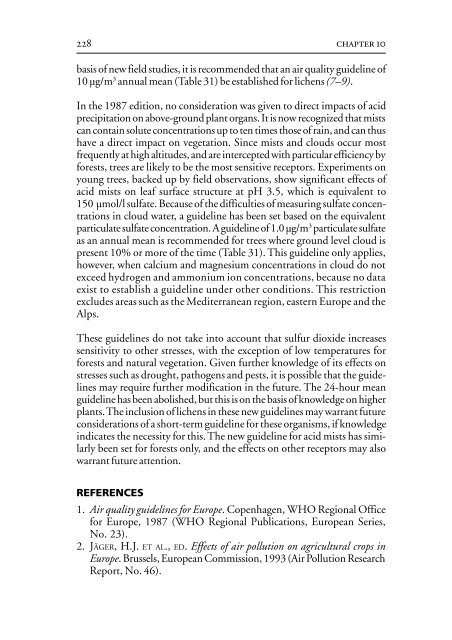Air Quality Guidelines - World Health Organization Regional Office ...
Air Quality Guidelines - World Health Organization Regional Office ...
Air Quality Guidelines - World Health Organization Regional Office ...
You also want an ePaper? Increase the reach of your titles
YUMPU automatically turns print PDFs into web optimized ePapers that Google loves.
228 chapter 10<br />
basis of new field studies, it is recommended that an air quality guideline of<br />
10 µg/m 3 annual mean (Table 31) be established for lichens (7–9).<br />
In the 1987 edition, no consideration was given to direct impacts of acid<br />
precipitation on above-ground plant organs. It is now recognized that mists<br />
can contain solute concentrations up to ten times those of rain, and can thus<br />
have a direct impact on vegetation. Since mists and clouds occur most<br />
frequently at high altitudes, and are intercepted with particular efficiency by<br />
forests, trees are likely to be the most sensitive receptors. Experiments on<br />
young trees, backed up by field observations, show significant effects of<br />
acid mists on leaf surface structure at pH 3.5, which is equivalent to<br />
150 µmol/l sulfate. Because of the difficulties of measuring sulfate concentrations<br />
in cloud water, a guideline has been set based on the equivalent<br />
particulate sulfate concentration. A guideline of 1.0 µg/m 3 particulate sulfate<br />
as an annual mean is recommended for trees where ground level cloud is<br />
present 10% or more of the time (Table 31). This guideline only applies,<br />
however, when calcium and magnesium concentrations in cloud do not<br />
exceed hydrogen and ammonium ion concentrations, because no data<br />
exist to establish a guideline under other conditions. This restriction<br />
excludes areas such as the Mediterranean region, eastern Europe and the<br />
Alps.<br />
These guidelines do not take into account that sulfur dioxide increases<br />
sensitivity to other stresses, with the exception of low temperatures for<br />
forests and natural vegetation. Given further knowledge of its effects on<br />
stresses such as drought, pathogens and pests, it is possible that the guidelines<br />
may require further modification in the future. The 24-hour mean<br />
guideline has been abolished, but this is on the basis of knowledge on higher<br />
plants. The inclusion of lichens in these new guidelines may warrant future<br />
considerations of a short-term guideline for these organisms, if knowledge<br />
indicates the necessity for this. The new guideline for acid mists has similarly<br />
been set for forests only, and the effects on other receptors may also<br />
warrant future attention.<br />
REFERENCES<br />
1. <strong>Air</strong> quality guidelines for Europe. Copenhagen, WHO <strong>Regional</strong> <strong>Office</strong><br />
for Europe, 1987 (WHO <strong>Regional</strong> Publications, European Series,<br />
No. 23).<br />
2. JÄGER, H.J. ET AL., ED. Effects of air pollution on agricultural crops in<br />
Europe. Brussels, European Commission, 1993 (<strong>Air</strong> Pollution Research<br />
Report, No. 46).

















